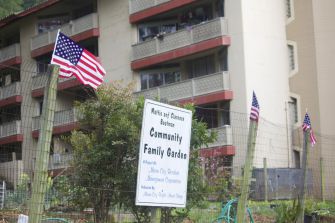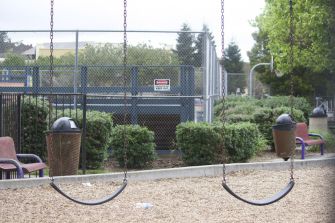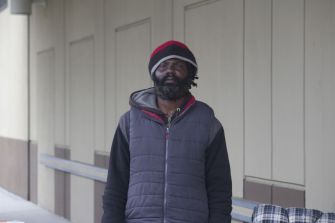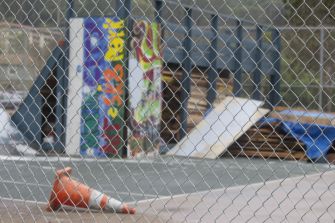The meeting started late, but not because they were unprepared.
The Hannah Center in Marin City’s Regional Shopping Center needed extra chairs to support the attendees of the annual ISOJI (Nigerian for “rebirth”) meeting, where representatives from nearly a dozen different social service and local government organizations gathered in seamless cohesion last month. Fresh batches of fried chicken and sweet potato pie preceded an introductory inquiry by ISOJI’s director, Ricardo Moncrief.
“What does working together look like?”
For Marin City, it’s a question rooted in a deep history of betrayal, neglect, and both geographic and cultural isolation from much of the county.
But for the unincorporated locality, a region governed by a distant county government as opposed to a local town council, the answer lies in the Hannah Center. The building neighbors the defaced and recently vacated Best Buy—a painful reminder of failed attempts to improve the community in the past through county initiatives. There, on a rainy Friday afternoon in a crowded conference room, an original brand of community collaboration emerged, bringing a long-awaited prospect of change to Marin’s most diverse population.
***

The fabric of the community was first formed more than 70 years ago during World War II, when workers at the nearby Sausalito shipyard needed temporary housing. Marin City, an isolated, unpopulated bowl, was an ideal destination for the war housing project.
Under federal supervision, the community thrived. Non-discriminatory rental laws made Marin City the first integrated housing project in America. The government provided housing, health care, recreation, financial aid, and protective services to residents. Marin City became a quintessential town, with a weekly newspaper, duly elected city council, post office, library, nursery and elementary schools, and more. In 1951, visiting writer Jack Kerouac observed Marin City to be “the only community in America where whites and Negroes lived together voluntarily; and that was so, and so wild and joyous a place I’ve never seen since.”
Unfortunately, the collapse of the community was on the horizon.
***
Recognizing that the temporary war housing project in Marin City was not built to last, the Marin Housing Authority stepped in to redevelop the area in 1952. Strangely, the transition of power from national to local levels proved to be catastrophic.
The mid-twentieth century project not only demolished deteriorating war housing, but also razed Marin City’s public buildings to clear space for roads. Nearly all of the flats were relegated to public housing.
As “white flight” occurred across the nation, black Marin City residents remained geographically trapped due to the discriminatory Proposition 14, an amendment to the state constitution that gave homeowners the right to deny property to buyers based on race. When the Marin County Committee on Racial Discrimination reported back to Marin County on the blatant racism that permeated local housing, the Board of Supervisors promptly ignored the findings and dissolved the committee altogether.
Richard Hahn, former chairman of the Task Force on Housing, also presented a report to the Board, detailing how 2,040 of Marin County’s 2,312 black residents lived in Marin City in 1965.
“One can only conclude that if one had intended by some diabolical premeditated design to isolate or eliminate the Negroes from Marin County…one could not have hoped for a more successful result,” Hahn said. “A result which could vindicate the most extravagant boasts of the most extreme segregationists.”
And, just as fast as Marin City was assembled, it transformed into a ghetto.
***

While most of Marin County rose atop the national ranks of income, education, and health, Marin City was left in the dust. The community was left with little money from property taxes because of public housing, and self-government was absent because of Marin City’s unincorporated status.
In the 1970s, residents remained tied down to their estates in Marin’s pocket of poverty due to housing restrictions. Marin City’s population was 90 percent black—Marin County was just 1 percent black.
Marin City native Nancy Johnson and her family left Marin County altogether after the redevelopment because of local housing discrimination and Marin City’s high drug and crime rates.
“There was this epidemic of cocaine use,” Johnson said. “That caused a lot of breakdown in family units. It really damaged our entire community.”
Even today, Johnson feels that the county government still has questions to answer regarding inequality in Marin.
“Why is it that we are struggling for transportation for restaurant workers when the restaurant closes and they can’t get back from work? Why is it that we are still having conversations about fair and equal housing? Equitable opportunities for all? Who are we talking to?” Johnson said.
Now a chair of the Marin City Community Services District, Johnson is a leading member of a new wave of social workers hoping to affect change in the community.
“I think the Board of Supervisors—the governing body of the county—should be involved in the interests of the entire population,” Johnson said.
***

How did such blatant disparities go unnoticed by a local government chock-full of resources? Perhaps the locality started a leg behind, struggling to overcome dilapidated infrastructure from wartime housing. Perhaps Marin City was just low on the list of priorities for the Board of Supervisors.
Regardless, after three decades of stagnation, Marin City is finally experiencing improvements thanks to cooperation between local government and community organizations. At the forefront of the new leadership are District 3 County Supervisor Kate Sears and her aide, Leslie Alden.
Alden, a fresh, female face in a local political scene crowded by white men, has taken an optimistic, hands-on approach with Marin City’s issues.
“If we can’t fix our problems in this petri dish of 3500 people—in one of the wealthiest counties in the nation—then we’re lost,” Alden said. “But I think we can.”
Both Alden and Sears have worked closely with the Marin City Community Services District (CSD) to better the community from the ground up. Together, they have diagnosed and addressed a handful of Marin City’s most pressing issues: education, unemployment, and health.
In the educational arena, cyclical poverty has pushed Marin City students far behind their county counterparts. At Tamalpais High School, Marin City teenagers are testing at 8 percent proficiency in math, 26 percent proficiency in history, and 42 percent proficiency in science. Yet, the attitude toward reversing these trends is hopeful and very convincing.
Whereas the primarily white Sausalito School District previously determined Marin City students’ curriculum, educational guidelines are now being crafted by Marin City residents to cater to the diverse population.
At Willow Creek Academy, a public charter school in Sausalito, Head of School Royce Conner has reformed disciplinary strategies that disproportionately affected black students. Since these changes, the school has seen a 90 percent drop in suspensions.
Last semester alone, 17 children from public housing finished with perfect attendance records, a testament to many families’ emphasis on education and the community’s grassroots organizing. Recreational opportunities in Marin City—largely lacking since Marin Housing Authority’s renovations—are now sprouting up around the locality.
Rocky Graham Park, the upshot of years of hard work on part of the Marin City CSD, is set to open in June. The park’s playground, amphitheatre, and synthetic turf playing field are primed to beautify an aesthetically bleak neighborhood. But, more important, the project has set a precedent for community building projects in the years to come.
Rather than hiring an outside firm to handle the construction of Rocky Graham Park, the Marin City CSD leveraged the public project by training local residents to develop the park. Now unionized, these workers can seek employment with other contractors, providing potential avenues out of poverty.
The new park will also aim to reduce the glaring health disparities between Marin City and the rest of the county, a wide gap illustrated by a recent Robert Wood Johnson Foundation survey that ranked Marin County the healthiest county in the state, yet 54 out of 57 counties in economic equality.
Marin City residents on average live 15 years fewer than those in surrounding communities. Residents are also more likely to suffer from increased rates of obesity, asthma, and stress.
One cause of these chronic health problems may have been a lack of accessibility to basic services in the community—a dentist, post office, and grocery store, to name a few—until recent years. The Marin City Health and Wellness Center has assuaged some of these health deficiencies through its programs in mental health, dental care, and other medical areas. However, Marin City, locally known as a “food desert,” remains the only Marin County community without a grocery store.
***

So what does working together look like?
The Marin City community, after decades of generational poverty and negative stigma from neighboring municipalities, is finally beginning to answer this question.
Local Marin City organizations and the county government, previously juxtaposing forces in the community, are finally cooperating to mend a broken system and lay the foundations for future success.
“We don’t have educators who look like us. We don’t have politicians who look like us. We lost some of the ‘Oh, I can do that,’” Johnson said. “We’re trying to rebuild the confidence that you not only have the right if you pursue it, but you should have the opportunity. You should have choices.”
The rebirth of what was once a bustling war town is not yet complete, but with promising new standards for education, employment, and health, Marin City’s social service organizations are digging themselves out of a hole, wiping their brows, and confidently passing the shovel to a determined community.


















